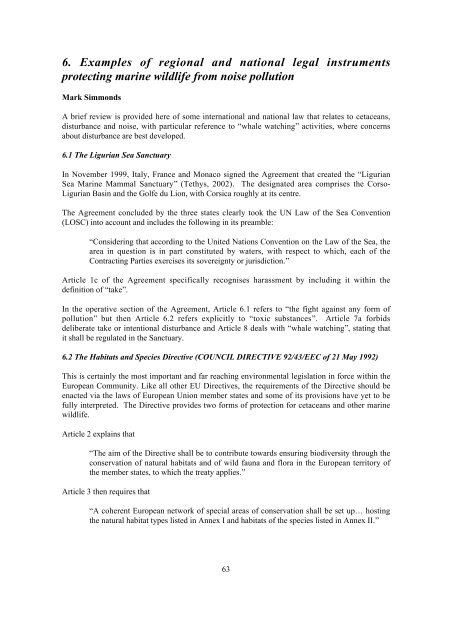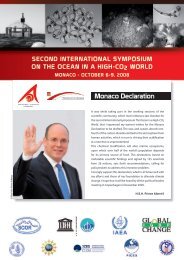6. Examples <strong>of</strong> regional <strong>and</strong> national legal instrumentsprotecting marine wildlife from <strong>noise</strong> pollutionMark SimmondsA brief review is provided here <strong>of</strong> some international <strong>and</strong> national law that relates to cetaceans,disturbance <strong>and</strong> <strong>noise</strong>, with particular reference to “whale watching” activities, where concernsabout disturbance are best developed.6.1 The Ligurian Sea SanctuaryIn November 1999, Italy, France <strong>and</strong> Monaco signed the Agreement that created the “LigurianSea Marine Mammal Sanctuary” (Tethys, 2002). The designated area comprises the Corso-Ligurian Basin <strong>and</strong> the Golfe du Lion, with Corsica roughly at its centre.The Agreement concluded by the three states clearly took the UN Law <strong>of</strong> the Sea Convention(LOSC) into account <strong>and</strong> includes the following in its preamble:“Considering that according to the United Nations Convention on the Law <strong>of</strong> the Sea, thearea in question is in part constituted by waters, with respect to which, each <strong>of</strong> theContracting Parties exercises its sovereignty or jurisdiction.”Article 1c <strong>of</strong> the Agreement specifically recognises harassment by including it within thedefinition <strong>of</strong> “take”.In the operative section <strong>of</strong> the Agreement, Article 6.1 refers to “the fight against any form <strong>of</strong>pollution” but then Article 6.2 refers explicitly to “toxic substances”. Article 7a forbidsdeliberate take or intentional disturbance <strong>and</strong> Article 8 deals with “whale watching”, stating thatit shall be regulated in the Sanctuary.6.2 The Habitats <strong>and</strong> Species Directive (COUNCIL DIRECTIVE 92/43/EEC <strong>of</strong> 21 May 1992)This is certainly the most important <strong>and</strong> far reaching environmental legislation in force within theEuropean Community. Like all other EU Directives, the requirements <strong>of</strong> the Directive should beenacted via the laws <strong>of</strong> European Union member states <strong>and</strong> some <strong>of</strong> its provisions have yet to befully interpreted. The Directive provides two forms <strong>of</strong> protection for cetaceans <strong>and</strong> other marinewildlife.Article 2 explains that“The aim <strong>of</strong> the Directive shall be to contribute towards ensuring biodiversity through theconservation <strong>of</strong> natural habitats <strong>and</strong> <strong>of</strong> wild fauna <strong>and</strong> flora in the European territory <strong>of</strong>the member states, to which the treaty applies.”Article 3 then requires that“A coherent European network <strong>of</strong> special areas <strong>of</strong> conservation shall be set up… hostingthe natural habitat types listed in Annex I <strong>and</strong> habitats <strong>of</strong> the species listed in Annex II.”63
The only cetaceans listed in Annex II are the harbour porpoise, Phocoena phocoena, <strong>and</strong> thebottlenose dolphin, Tursiops truncatus.Article 12 refers to another list <strong>of</strong> species (i.e. Annex IV, which includes all cetaceans) <strong>and</strong>establishes a range <strong>of</strong> measures that should be applied to them. This includes prohibition in theirnatural range <strong>of</strong>:(a) all forms <strong>of</strong> deliberate capture or killing, <strong>and</strong>(b) deliberate disturbance <strong>of</strong> these species, particularly during the period <strong>of</strong> breeding, rearing <strong>and</strong>hibernation.There are some derogations that apply to these measures but they are outside the scope <strong>of</strong> thispaper.Since the Directive was passed, national laws will have been modified. For example, in the UK,laws have been amended <strong>and</strong>, in addition, three bottlenose dolphin Special Areas <strong>of</strong> <strong>Conservation</strong>(SACs) have been proposed (these are presently classified as “c<strong>and</strong>idate sites”, whilst theEuropean Commission is considering all proposals). No sites for porpoises have been proposed inthe UK..The issue <strong>of</strong> whether, or not, this Directive applied to the UK’s full Economic Exclusion Zone(rather than only territorial waters) was the subject <strong>of</strong> a recent Judicial Review 4 . Several aspects<strong>of</strong> the resulting judgement are <strong>of</strong> interest. Firstly, the presiding judge concluded that theDirective did apply to the UK Continental Shelf <strong>and</strong> to the “superadjacent waters up to a limit <strong>of</strong>200 nautical miles from the baseline from which the territorial sea is measured.”In addition, considerable evidence was submitted to the Judicial Review concerning the threatcaused by <strong>of</strong>fshore oil <strong>and</strong> gas development, including the disturbance it might create. The judgecommented:“the evidence <strong>and</strong> materials provided...are to the effect that oil exploration, includingseismic activity, is harmful to cetaceans <strong>and</strong> has serious implications for conservation.There is no real evidence to the contrary before me. I shall proceed on the basis that it issubstantially correct.”Amongst the measures currently enacted in UK <strong>of</strong>fshore waters <strong>and</strong> which might be said to meetthe requirements <strong>of</strong> the Habitats <strong>and</strong> Species Directive are “Seismic Guidelines”, issued to thefossil fuels industry. These guidelines are intended as mitigation in relation to the very loud<strong>noise</strong>s used in marine prospecting.The UK Countryside <strong>and</strong> Rights <strong>of</strong> Way Act, passed in 2000, made “reckless” (in addition todeliberate) disturbance <strong>of</strong> cetaceans (<strong>and</strong> basking sharks) an <strong>of</strong>fence.However, it may be that, in practice, what constitutes ‘disturbance’ is not presently adequatelydefined <strong>and</strong>, similarly, interpretation <strong>of</strong> the terms “deliberate” <strong>and</strong> “reckless” may presentproblems. The IWC Scientific Committee <strong>and</strong> other expert bodies could play an important role inhelping to define these terms.34 R v Secretary <strong>of</strong> State for Trade <strong>and</strong> Industry, ex parte Greenpeace Ltd ([2000] 2 CMLR 94).64
- Page 2:
Oceans of Noise 2004A WDCS Science
- Page 8 and 9:
In the US, the deployment of Low Fr
- Page 10 and 11:
its propagation beyond those declar
- Page 12 and 13:
The best evidence for noise being f
- Page 14 and 15: Box 1. Characteristics of sound / l
- Page 16 and 17: Sound speed (c)The speed (c) of a w
- Page 18 and 19: Box 2. The effects of temperature,
- Page 20 and 21: 2.1.2. Measuring sound intensityIde
- Page 22 and 23: i.e. Equal pressure measurements di
- Page 24 and 25: Spherical or Geometrical spreading
- Page 28 and 29: 5.0 145Tug pulling loaded barge 1.0
- Page 30 and 31: The source used during 3-D surveys
- Page 32 and 33: Machinery noisePropulsion machinery
- Page 34 and 35: Man-made islands /caissonsFixed pla
- Page 36 and 37: 12 3245Drill bit6Figure 3.4. Sound
- Page 38 and 39: Transientnoise sourcesAircraftHelic
- Page 40 and 41: Results from the aerial surveys con
- Page 42 and 43: haemorrhaging in the inner ears and
- Page 44 and 45: However they also noted that whales
- Page 46 and 47: 4. The Use of Sound by CetaceansChr
- Page 48 and 49: seems logical, therefore, that if t
- Page 50 and 51: However, despite the reported low a
- Page 52 and 53: Kamminga and Wiersma 1981;Akamatsu
- Page 54 and 55: SongSocial callsShrieksSlaps0.03-80
- Page 56 and 57: anthropogenic factors that make the
- Page 58 and 59: 5.3 Longer-term impactsNoise is cle
- Page 60 and 61: 5.4 Indirect impactsThe above impac
- Page 62 and 63: decompression sickness (DCS) as see
- Page 66 and 67: 6.3 ASCOBANS and ACCOBAMSTwo region
- Page 68 and 69: implications and the discussion sho
- Page 70 and 71: 7.1. Consideration of Voluntary vs.
- Page 72 and 73: acoustic measurements have been mad
- Page 74 and 75: 7.6. Methods of protectionComplianc
- Page 76 and 77: 7.6.1 Monitoring7.6.1.1 Visual, aco
- Page 78 and 79: Delory et al. (2002) use Ambient No
- Page 80 and 81: 8. ReferencesAburto, A., Rountry, D
- Page 82 and 83: Caldwell, M.C., Caldwell, D.K., and
- Page 84 and 85: Engas, A., Lokkeborg, S., Ona, E. a
- Page 86 and 87: IWC 2002b. Report of the Scientific
- Page 88 and 89: McCauley, R.D. 1994. Seismic Survey
- Page 90 and 91: Potter, J. and Delory, E. 2001. Noi
- Page 92 and 93: Smolker, R.A., Mann, J. and Smuts,
- Page 94 and 95: Watkins, W.A. 1981b. The activities
- Page 96 and 97: ANNEX 1The Application of Marine Po
- Page 98 and 99: an important factor. 13 The judgeme
- Page 100 and 101: in the preparatory work of the LOSC
- Page 102 and 103: practice by the UNEP Governing Coun
- Page 104 and 105: protection and preservation of the
- Page 106 and 107: than international rules, standards
- Page 108 and 109: Four of the twelve regional seas tr
- Page 110 and 111: seismic operations in the Protocol
- Page 112 and 113: ConclusionAt the global level, only
- Page 114 and 115:
Art 209 LOSC focuses on both standa
- Page 116 and 117:
No State Party may impose condition
- Page 118 and 119:
coastal States”. This formulation
- Page 120 and 121:
If the IMO makes this determination
- Page 122 and 123:
estrictions to vessels operating in
- Page 124 and 125:
In the EEZ, in comparison to the te
- Page 126 and 127:
Appendix A - Some international ins
- Page 128 and 129:
Convention for the Protection of th
- Page 130 and 131:
Available at:http://www.unep.ch/sea
- Page 132 and 133:
BucharestConventionArticle XIPollut
- Page 134 and 135:
environment1. The Contracting Parti
- Page 136 and 137:
- that under Article III.8.c) of AC
- Page 138 and 139:
e) no sudden or repeated change in
- Page 140 and 141:
Ref: Nowacek et al. 2001.Location:
- Page 142 and 143:
Location: Arctic• Vocal behaviour
- Page 144 and 145:
• Vaquita surfacing duration and
- Page 146 and 147:
• 6% of small delphinids (n=264;
- Page 148 and 149:
Species type: Boto, Inia geoffrensi
- Page 150 and 151:
• Humpback whales appeared tolera
- Page 152 and 153:
• Behaviour interpreted as aggres
- Page 154 and 155:
• There was no evidence of minke
- Page 156 and 157:
• Northern right whales may be ap
- Page 158 and 159:
• Migrating gray whales disturbed
- Page 160 and 161:
to Ensenada De La Paz, Mexico. Aqua
- Page 162 and 163:
distribution of humpback whales, Me
- Page 164 and 165:
Richardson, C.R. Greene, C.I. Malme
- Page 166 and 167:
Zhou, K., Pilleri, G. and Li, Y. 19
- Page 168 and 169:
6. surveys for Cuvier’s beaked wh




